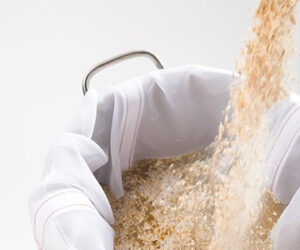Effective Lautering: Tips from the Pros
Brewer: Mikoli Weaver
Education: BS in food and science bio-chemistry from Universtiy of Washington; degree from Instituto di Cucina e Science, Tuscany
To effectively lauter you need to effectively mash. Make sure you don’t disturb the mash process. I have a combination mash/lauter tun, so my grain just sits in the same bed. Then I hook a sparge arm to it just like most homebrewers do.
Some people are forced to transfer to a separate vessel for lautering. I am not tremendously familiar with that method. I know sometimes you can have better extraction because of that, but I think recirculation sort of achieves the same thing, although not to the same extent. After all, you’re taking the entire mash out and putting it somewhere. I would rather keep it in the same vessel so as not to disturb the grain but instead move the wort through it. Trying it both ways at home I found that leaving the grain in the same vessel reduces the chance of a stuck mash. Less chance of a stuck mash increases your extraction.
During the mash pay attention to your dilution so you have the same level every time. It helps with consistency all around. Especially useful in homebrewing is the ratio 1.25 quarts of water per pound of grain (2.6 L/kg). It will depend on the size and shape of your mash tun, but generally it works well. Given that, you’ll know exactly how much water you’ll need to sparge on top.
Once you have applied the ratio of water to grain, consider temperature. I mash at 149 °F (65 °C). That temperature is too low to be considered the optimum for alpha-amylase conversion, but the beta-amylase is more active at that particular temperature. Even with a minimum of alpha activity, you can break down the more complex bonds. If you have a long chain of starch with branches in the molecule (amylopectin) the alpha-amylase will break this large piece into smaller pieces by attacking from the middle. Beta-amylase, which attacks from the ends, can now produce fermentable sugars out of the smaller starch pieces. So because the beta thrive in lower temperatures than alphas, I mash a little lower than most people would. I find I get better conversion that way.
Now if your malt is highly modified, it is sometimes necessary to mash a little higher because it is ready to be broken down into carbohydrates; the enzyme that does that works best at high temperatures. Domestic two-row at 149 °F (65 °C) works, plus or minus a degree. That should go about an hour to 1.25 hours. When the starch test is negative, start to sparge with 170–172 °F (77–78 °C) water.
Make sure you have plenty of water on top of what you’re sparging. That way you won’t create as many channels. I try to keep a good two to three inches of water on top to maintain a good filter all the way around. Don’t be afraid — at home especially — to recirculate your wort through the grain bed. Let it sit another 15 minutes to establish a little more of a filter bed. Recirculation can help keep your lipid content down as the last of the wort comes. Lipids inhibit foam retention later on and somewhat in fermentation. Recirculation is almost like establishing a drain of rock and sand — one layer of heavy rock, then smaller and smaller particles on top. Turn that upside down and that’s what your mash looks like.
If I do a half batch, it’s not necessary to underlet because there is no danger of having a stuck mash. But if I’m brewing a stout, it’s necessary to underlet with a little hot water. At home I can’t see that would be too necessary if you recirculate really well.


